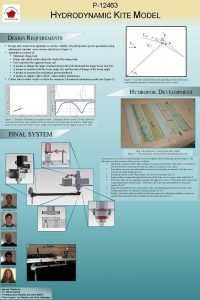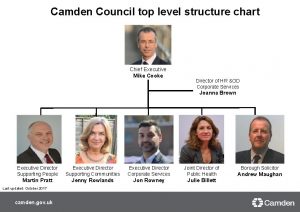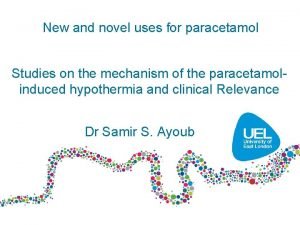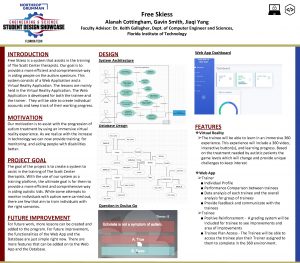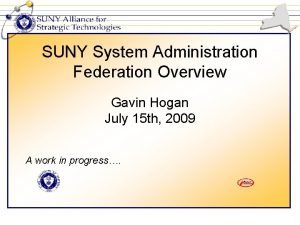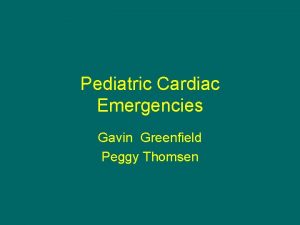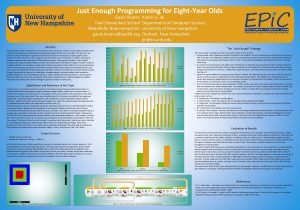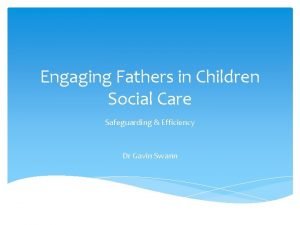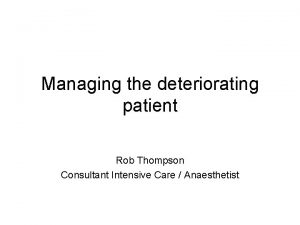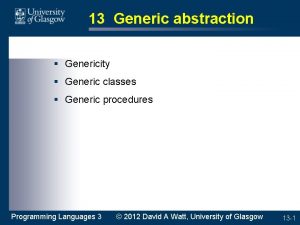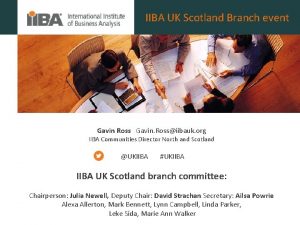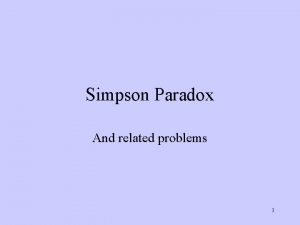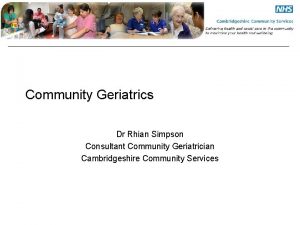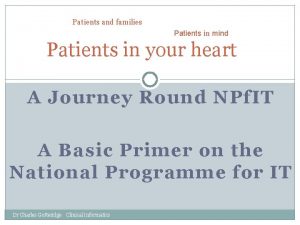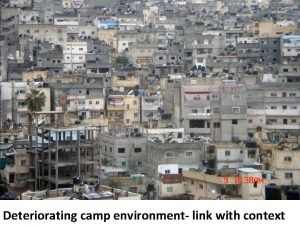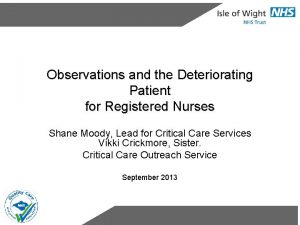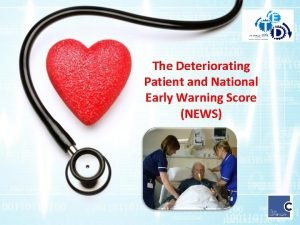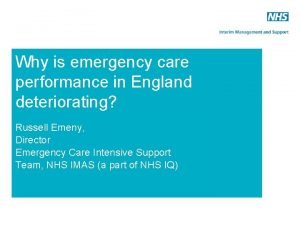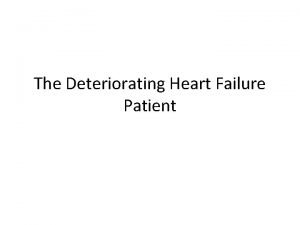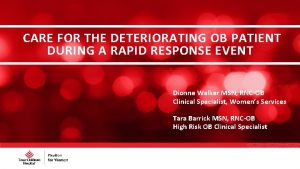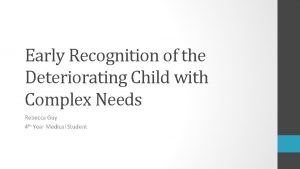Generic Response for Deteriorating Patients Gavin Simpson Consultant



































- Slides: 35

Generic Response for Deteriorating Patients Gavin Simpson Consultant Anaesthetist, NHS Fife Wendy Nimmo Associate Improvement Advisor, Healthcare Improvement Scotland #SPSPDet. Pat

Background • Deteriorating patients have been a key focus for the SPSP since its launch in 2008. Acute hospitals now have an improved approach to identifying and treating deteriorating patients quickly and effectively. • Existing work: National Early Warning Score (NEWS) Sepsis recognition & treatment Escalation processes Person-centred care planning 29% reduction in cardiac arrest rate since Jan 2016 21% reduction in Sepsis mortality since April 2013 • The work to date has identified an emerging need to better describe and support the different ways to recognise and respond to physiological deterioration from any cause. #SPSPDet. Pat

#SPSPDet. Pat

Safety • To be a SAFE hospital • Avoid HARM • Minimise damage when it does happen • Prevent from happening in first place #SPSPDet. Pat

#SPSPDet. Pat

HARM Deterioration #SPSPDet. Pat

Deterioration #SPSPDet. Pat

INAPPROPRIATE CPR or FAILURE TO RESCUE HIGH MORTALITY RATE NO SECOND CHANCES ULTIMATE HARM #SPSPDet. Pat

Cardiac Arrest Rates per 1000 Admissions 2015 #SPSPDet. Pat

Nearly half the CPR in hospital avoidable 1 2 3 4 5 6 7 8 9 CPR Review outcomes: 1 - Appropriate response to deterioration 2 – Cardiac arrest unexpected, unavoidable and 2222 call appropriate 3 – DNACPR order should have been considered / would have benefitted patient 4 – DNACPR in place but resuscitation attempted 5 – Failure to recognise patient deterioration 6 – Failure to respond to patient deterioration 7 – Failure to refer to higher level of care 8 – Cardiac arrest could have been avoided with different intervention. 9 – Referral to SAER #SPSPDet. Pat

Every system is perfectly designed to achieve the results it gets Don Berwick . • inputs . • actions . • outcomes #SPSPDet. Pat

Triage Deteriorating Patient Higher level of care 1 Manage in situ 2 Observations Taken Clinical Help Called For DNACPR Medical Response Limitation 3 #SPSPDet. Pat

inputs • EWS #SPSPDet. Pat

EWS scores associated with cardiac arrests and mortality R is 0. 5526. p= 0. 014. (5 million sets obs 70, 000 patients) #SPSPDet. Pat

Triggers for Triage? • AKI - x 4 Mortality in hospital • Lactate - Mortality > 30% if > 4 mmol/l • Patient /Carer Concern • EWS - Mortality correlation p < 0. 001 • Delirium – mortality 22 -76% in hospital #SPSPDet. Pat

#SPSPDet. Pat

Triage Deteriorating Patient Higher level of care 1 Manage in situ 2 Observations Taken Clinical Help Called For DNACPR Medical Response Limitation 3 #SPSPDet. Pat

• Multiple changes in teams • Multiple handovers • Flicking through notes at 3 am trying to find out about patient • Trying to ID priorities. . . #SPSPDet. Pat

Reasons for no response • Results: The incidence of physiological instability in the acute adult population was 4. 04%. Nearly half of these patients (42%) did not receive an appropriate clinical response from the staff, despite most (69. 2%) recognising their patient met physiological criteria for activating the RRS, and being ‘quite’, or ‘very’ concerned about their patient (75. 8%). Structured interviews with 91 staff members identified predominantly sociocultural reasons for failure to activate the RRS. #SPSPDet. Pat 19

Actions Atul Gawande 13, 000 diagnoses 6, 000 drugs 4, 000 procedures #SPSPDet. Pat

DETERIORATING PATIENT DECISION FLOW CHART THIS calcium snake IS SILLY RR Fish suppers Call someone panalgesia stairs SHDU ABG MRI CT scan Peanut score oxygen Supine BP xray bilirubin etoh AND Call 2222 WILL BP frailty mobility NEVER ladder Roll again smoking WORK #SPSPDet. Pat

Triage Deteriorating Patient Higher level of care 1 Manage in situ 2 Observations Taken Clinical Help Called For DNACPR Medical Response Limitation 3 #SPSPDet. Pat

Poor System Sensitivity 50% x 80% • 26% best possible Suboptimal Observation rates Inaccuracies in Calculations Human Factors Communications Problems #SPSPDet. Pat

outputs Outputs Cardiac Arrests ? 2222 calls ? Mortality ? ITU admissions? Communication ? Chain Length? Obs Accuracy ? #SPSPDet. Pat

outputs Outputs CHAIN LENGTH Time to TRIAGE OR CLINICAL IMPROVEMENT 280 244 min 260 240 220 200 180 160 140 120 100 30 % Improvement #SPSPDet. Pat

EWS #SPSPDet. Pat

EWS > 3 Trigger EWS >4 Action or EWS > 7 Then Call For Help #SPSPDet. Pat

2015 2019 2018 2016 Reduction avoidable cardiac arrests #SPSPDet. Pat

SAFETY NET Simple - Triggers Simple - Decisions Simple - Communication All preventable Cardiac Arrests prevented All avoidable CPR avoided #SPSPDet. Pat

Approach • 90 -Day learning cycle used to explore the benefits and risks of this development. • This is a methodology for understanding and developing new concepts and provides a reliable and efficient way to explore ideas, assess their potential and bring them to action. #SPSPDet. Pat

Aim The aim of this work is to develop a better understanding of: • The key components of a generic response to a deteriorating patient, • How this could be tested in clinical practice, and • The potential benefits and challenges of a generic response for staff and patients. #SPSPDet. Pat

Outcome • By the end of the process, we will have explored the potential for a method for recognition and response for people who are acutely deteriorating from any cause. • We will have tested this approach with a view to further testing and implementation within boards. #SPSPDet. Pat

What have we done? Phase 1 Reviewed existing literature and spoke to experts in the field to develop an understanding of: • the key components in the implementation of a generic response to a deteriorating patient, • how complex this could be, and • the benefits of a generic response to staff and service users. Phase 2 Building on the literature review and expert interviews conducted in phase 1 of the process, we consulted with experts in the field to co-design a generic response for deteriorating patients to be tested in NHS boards. #SPSPDet. Pat

What happens next? • During Phase 3, we will review tests and further refine the initial prototype for a generic response to deteriorating patients. A report will be developed to outline the learning from the 90 Day Process. #SPSPDet. Pat

Over to you…. • Do you think the concept of a generic response to deteriorating patients has potential? • Is there anything that you think should be incorporated into the response that was not addressed here? #SPSPDet. Pat
 5 whys jefferson memorial powerpoint
5 whys jefferson memorial powerpoint Simpsons evenness
Simpsons evenness Gavin davies imperial
Gavin davies imperial Gavin cameron
Gavin cameron Gavin is designing a kite
Gavin is designing a kite Ifrs 9
Ifrs 9 Gavin greenfield
Gavin greenfield Jon rowney camden
Jon rowney camden Gavin smith wren academy
Gavin smith wren academy The china market research group
The china market research group Gavin giovannoni
Gavin giovannoni Pc gavin smith
Pc gavin smith Suny central administration
Suny central administration Let's divide and conquer
Let's divide and conquer Tet spell
Tet spell Gavin kearns
Gavin kearns Gavin swann
Gavin swann Ending gavin ewart
Ending gavin ewart Gavin cameron
Gavin cameron Gavin baldwin
Gavin baldwin Wendy gavin
Wendy gavin Gavin soorma
Gavin soorma Gavin cameron
Gavin cameron Kevin gavin
Kevin gavin Gavin cotter
Gavin cotter Gavin corey
Gavin corey Natural and forced response
Natural and forced response What is natural response
What is natural response A subsequent
A subsequent Mantel för kvinnor i antikens rom
Mantel för kvinnor i antikens rom Tidbok
Tidbok Modell för handledningsprocess
Modell för handledningsprocess Vilken grundregel finns det för tronföljden i sverige?
Vilken grundregel finns det för tronföljden i sverige? Jätte råtta
Jätte råtta Verktyg för automatisering av utbetalningar
Verktyg för automatisering av utbetalningar Ministerstyre för och nackdelar
Ministerstyre för och nackdelar




